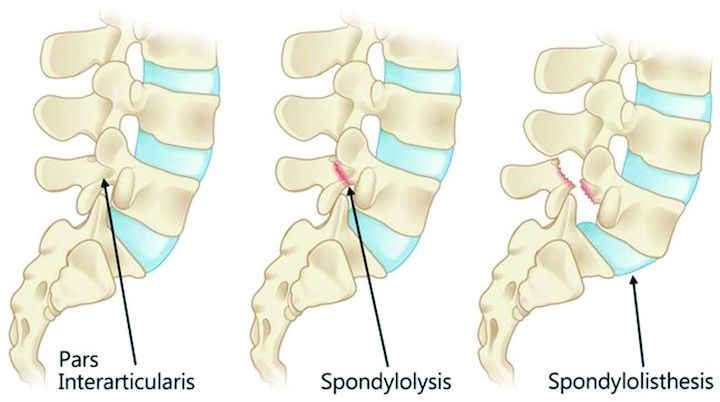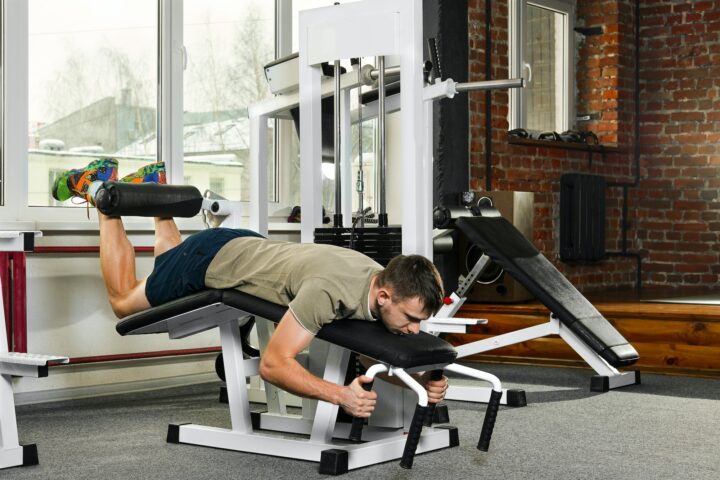Spondylolysis is a stress fracture of the lower spinal vertebral region called the pars interarticularis. This common cause of back pain in children and adolescents often heals well with conservative treatment. However, it can potentially progress to spondylolisthesis if the fracture leads to vertebral slippage. This article provides an in-depth overview of what causes spondylolysis, how it is diagnosed, and both nonsurgical and surgical treatment options.
Spondylolysis refers to a stress fracture of the pars interarticularis, a narrow piece of bone connecting the upper and lower facet joints. This lumbar spinal cord region is prone to stress fractures.
It most often affects the fifth lumbar vertebra (L5) but can occur at other lumbar spine levels. Lumbar spondylolysis leads to structural weakness and mobility at that spinal segment. Sometimes, it can progress to spondylolisthesis where a vertebra slips forward out of alignment.
Spondylolysis is present in up to 47% of some athlete populations. It has a prevalence of 3-7% in the general population. It is considered an overuse injury caused by repetitive stress on the lower back.
Spondylolysis and spondylolisthesis are both spinal conditions that can cause lower back pain and discomfort, but they differ in important ways. The former occurs when there is a fracture in the vertebra due to stress, typically the pars interarticularis. This can be caused by repetitive stress or a congenital defect.

Photo Credit: Journal of the American Board of Family Medicine
On the other hand, when one vertebra slips forward or backward in relation to the adjacent vertebrae, it results in a condition called spondylolisthesis. Spondylolysis is a common cause as well, but it can also be caused by degenerative changes in the spine, trauma, or certain medical conditions.
Determining if your condition is spondylolysis or spondylolisthesis is an important part of your recovery process. So, make sure to give a detailed description of the discomfort you’re having to the health professional.
In both cases, patients may experience pain, stiffness, weakness, and numbness, but the specific symptoms can vary depending on the severity and location of the condition. Treatment process for cases of spondylolysis and spondylolisthesis can range from conservative measures such as pain medication, rest, and physical therapy, to more invasive interventions like spinal fusion surgery. It is crucial for individuals experiencing these symptoms to seek medical attention in order to accurately diagnose and manage their condition.
Several factors raise the risk of developing a stress fracture in the lumbar spine:
Engaging in a high volume of sports requiring repeated back hyperextension significantly raises the risk especially if underlying risk factors for spondylolysis are already present.

Photo Credit: D. Zinkevych, Envato Elements
Patients with spondylolysis may develop the following symptoms:
Seeking early evaluation for persistent back pain helps detect the condition before significant damage occurs. Pain that limits sports participation warrants medical assessment.
Typical steps to diagnose spondylolysis include:
Finding the exact site of the pars fracture dictates the appropriate treatment approach.

Photo Credit: Elina Fairytale, Pexels
Most young athletes respond well to conservative treatment involving:
If chronic symptomatic spondylolysis fails to improve with at least 6 months of conservative treatment, surgical options include:
Surgery aims to relieve pain and prevent progression to spondylolisthesis. Before choosing surgery, extensive discussion of risks and benefits with the surgeon is recommended.
Physical therapists instruct patients on exercises that strengthen the back without overstressing the healing pars fracture. Goals include:
Low-impact aerobic conditioning maintains fitness without jarring the fracture site.
Strategies athletes can use to avoid developing the condition include:
Being proactive helps reduce the chances of a spondylolysis occurring.
Most young athletes fully recover within 3 to 6 months with appropriate conservative treatment. However, 15-20% develop chronic symptoms lasting beyond 6 months. In these cases, surgical fusion may be required. Outcomes are generally good with rigid adherence to post-operative restrictions to allow complete healing.

Photo Credit: BoomArt, Envato Elements
If asymptomatic, most can return to sports by 8 to 12 months post-injury, gradually increasing activity under guidance. Some modification to high-risk techniques may be needed to prevent recurrence. Regular screening of at-risk athletes aims to detect spondylolysis early before it progresses to spondylolisthesis.
It can be a serious problem if not addressed, as it can lead to chronic back pain and progression to spondylolisthesis in some cases. However, with proper treatment, spondylolysis often heals well, especially in youth.
It is caused by repetitive stress on the pars interarticularis region of a vertebra leading to a fracture, most commonly in the low back. Sports requiring hyperextension of the spine increase risk.
It frequently heals with rest and bracing within 3-6 months in children and adolescents. In adults, it may develop into a chronic issue requiring surgery if conservative treatment fails.
The most common cause is repetitive hyperextension and stress to the lower back from sports like gymnastics, weight lifting, football, wrestling, dance, and diving during adolescent growth spurts.
Treating this condition usually involves rest and physical therapy programs to strengthen the core, and pain relief medications. In cases where a pars fracture is present, a brace may be used to immobilize the area. Severe cases may need surgery for spondylolysis.
Spondylolysis refers to a fracture or defect in the pars interarticularis of the vertebra, often due to stress or trauma. Spondylolisthesis, on the other hand, occurs when a vertebra (commonly the L5) slips forward over the one below it, which can be caused by spondylolysis.